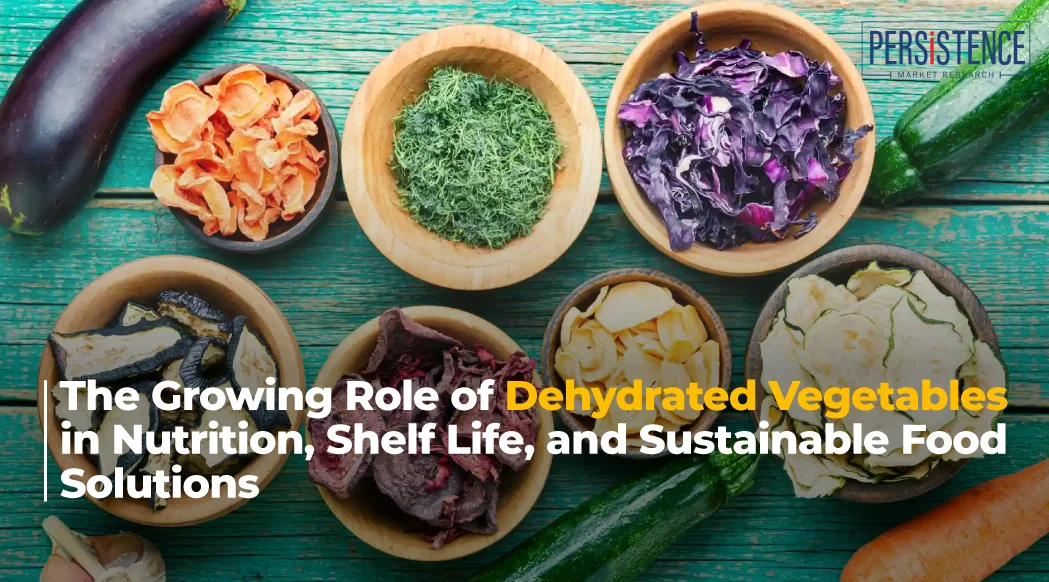- Blog
- Dehydrated Vegetables Nutrition Shelf Life Sustainability
The Growing Role of Dehydrated Vegetables in Nutrition, Shelf Life, and Sustainable Food Solutions
Published On : 20 Aug 2025
Food systems across the world continue to face significant challenges like post-harvest losses, high perishability of fresh produce, and unequal access to nutrition. According to estimates by the Food and Agriculture Organization (FAO), over one billion tons of food are wasted each year, with fruits and vegetables accounting for a considerable share of this loss.

Dehydrated vegetables are emerging as a practical and sustainable solution to these issues. By extending shelf life while retaining the majority of nutrients, they play a vital role in improving food availability, reducing waste, and supporting consumer health.
Defining Dehydrated Vegetables
Dehydrated vegetables are fresh vegetables that undergo carefully controlled drying methods, including air drying, freeze drying, vacuum drying, or spray drying. The removal of water inhibits microbial growth and slows enzymatic activity, which helps preserve the product for extended periods. Unlike heavily processed alternatives such as canned vegetables, dehydrated products typically do not require chemical preservatives. They also maintain a significant portion of their natural flavor, color, and nutritional value, which is why they are increasingly preferred in both consumer and commercial settings.
Nutritional Composition and Health Advantages
Although dehydration reduces heat-sensitive vitamins such as Vitamin C, the overall nutrient profile remains strong. Essential minerals, dietary fiber, and plant-derived compounds like carotenoids and flavonoids are largely preserved. As a result, dehydrated vegetables provide a concentrated source of nutrition. Since water is removed, the nutrient density per gram is higher, meaning that smaller portions meaningfully contribute to dietary intake. Another advantage is the reliability they provide in contexts where refrigeration is limited, since their longer shelf life ensures that vegetables remain available and edible for months or even years. In this way, dehydrated vegetables contribute to better dietary diversity and more consistent nutrition in both developed and developing regions.
Applications in Industry and Consumer Markets
The adaptability of dehydrated vegetables makes them indispensable in a wide range of uses. In the food manufacturing sector, they are key ingredients in instant noodles, ready-to-cook mixes, sauces, and seasoning blends. In hospitality and institutional catering, they enable bulk preparation while ensuring consistent quality and reducing preparation time. They are also critical in emergency supplies, military rations, and outdoor recreation foods because they are lightweight and durable. Furthermore, their role in international trade is significant since the reduction in weight and spoilage risk improves supply chain efficiency. These varied applications demonstrate how dehydrated vegetables are not only relevant to household kitchens but equally essential to large-scale global food systems.
Environmental and Sustainability Considerations
Dehydrated vegetables also align with sustainability objectives. Because they are lighter than fresh produce, they require less packaging, occupy less space during transport, and generate lower carbon emissions. Farmers and processors can convert surplus harvests into dehydrated products, which significantly reduces food waste at the source. This process ensures that more of the agricultural yield contributes to human nutrition instead of being discarded. The overall effect is a product that supports both environmental goals and food security priorities.
To what extent do dehydrated vegetables compare nutritionally with fresh produce?
Fresh vegetables are widely considered the benchmark for optimal nutrition, yet dehydrated vegetables maintain most of their essential value. Minerals such as calcium, potassium, and iron are well preserved, along with dietary fiber and many plant antioxidants. Although some reduction occurs in certain vitamins, particularly Vitamin C, the nutrient concentration in dehydrated vegetables is often greater because of the removal of water. This means that a smaller portion of dehydrated vegetables can sometimes provide a similar or even greater nutrient intake than the same weight of fresh produce.
Beyond nutrient contents, the stability of dehydrated vegetables makes them valuable in situations where fresh produce is not viable, whether due to limited refrigeration or extended storage needs. They ensure continuity of nutrition in remote areas, during emergencies, or across long distribution chains. For this reason, dehydrated vegetables are not intended to replace fresh vegetables but instead to serve as a complementary option that bridges gaps in access and storage.
How are dehydrated vegetables effectively integrated into daily and commercial food preparation?
The incorporation of dehydrated vegetables into food preparation is both practical and diverse. In most cases, they can be rehydrated in warm water before cooking, which restores much of their original texture and flavor. They can also be added directly to soups, stews, and sauces, where they absorb water during the cooking process.
For example, dehydrated onions and garlic are widely used as the base of spice mixes and sauces, while carrots, peas, and beans enrich rice dishes, casseroles, and curries.
Leafy vegetable powders made from spinach, kale, or beetroot are increasingly added to smoothies, baked products, and fortified foods to enhance nutritional content. Snack products such as vegetable chips and trail mixes are another growing application, addressing the demand for healthier alternatives in the convenience food segment.
In large-scale operations, such as airline fleets, institutional catering, and packaged food manufacturing, dehydrated vegetables offer clear advantages. They reduce preparation time, allow for consistency in flavor and quality, and lower storage costs, all of which make them highly efficient for commercial use.
Market Outlook for Dehydrated Vegetables
Growing consumer demand for health, convenience, and sustainability is expected to drive the continued expansion of the dehydrated vegetables market. Advances in drying technologies, particularly vacuum and freeze drying, are further improving nutrient retention and sensory qualities such as taste and texture. These improvements make dehydrated vegetables more attractive not only to individual consumers but also to institutional buyers.
For households, they represent an easy and reliable means of ensuring balanced meals with minimal preparation. For businesses and policymakers, they provide a tool to combat food waste, strengthen food security, and support sustainable supply chains. The adoption of dehydrated vegetables is therefore not simply a dietary shift but also a strategic response to global nutritional and environmental challenges.
Industry Report

Request Report Sample
Your privacy is important to us; your data is secure
Contact Us
Latest Reports
-
Piezoresistive Pressure Sensor Market by Sensor Type (Absolute, Gauge, Differential, Sealed), Pressure Range (Low Pressure (<10 kPa), Medium Pressure (10 kPa – 1000 kPa), High Pressure (>1000 kPa)), End-Use Industry (Automotive & Transportation, Industrial Manufacturing, Healthcare, Aerospace & Defense, Electronics) and Regional Analysis for 2026-2033
-
Aquarium Accessories Market by Product Type (Filtration Items, Lights & Hoods, Temperature Control Systems, Others), End-User (Residential, Commercial), Distribution Channel (Online, Offline), and Regional Analysis for 2026-2033
-
Oxygen Therapy Market by Product Type (Compressed Oxygen, Concentrated Oxygen, Liquid Oxygen), Disease (Respiratory Disorder, Cardiovascular Disease, Sleep Apnea, Pneumonia), End-User (Hospitals, Home Healthcare, Clinics), and Regional Analysis for 2026-2033
-
Air Curtains Market by Product Type (Non‑Recirculating, Recirculating, Heated, Others), Airflow Capacity (Up to 500 m³/h, 500–1000 m³/h, 1000–1500 m³/h, Above 1500 m³/h), Application (Commercial, Industrial, Residential, Others), and Regional Analysis for 2026–2033
-
Personalized Stationery Market by Product type (Storage & Filling Products, Paper-Based Products, Drawing & Writing Instruments, Accessories, Bags, Others), Application (Educational Institutes, Corporate Offices, Personal Use, Hospitals, Others), and Regional Analysis for 2026–2033
